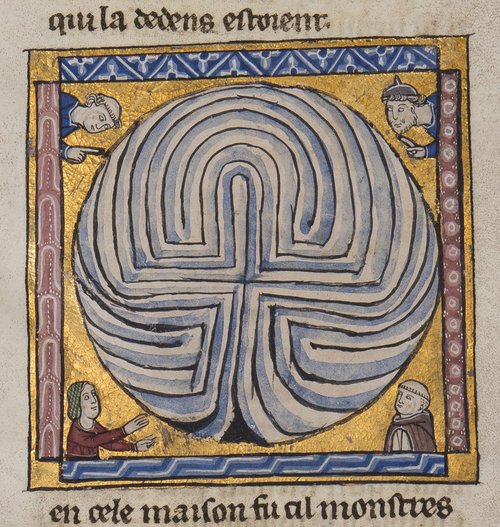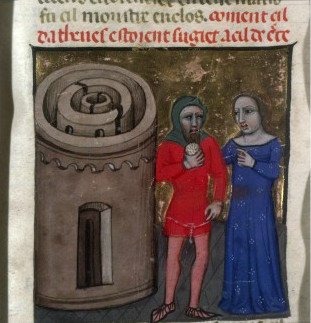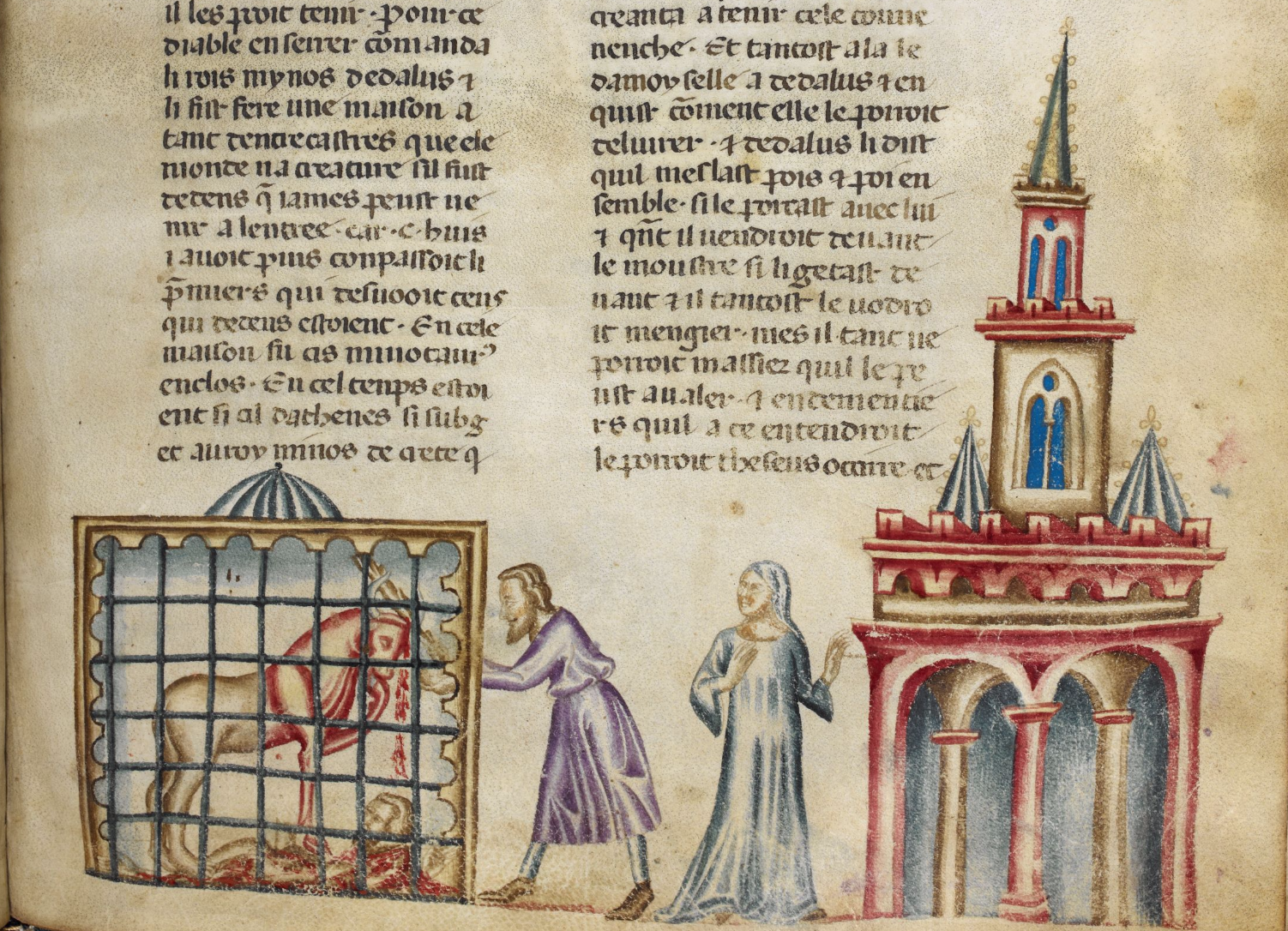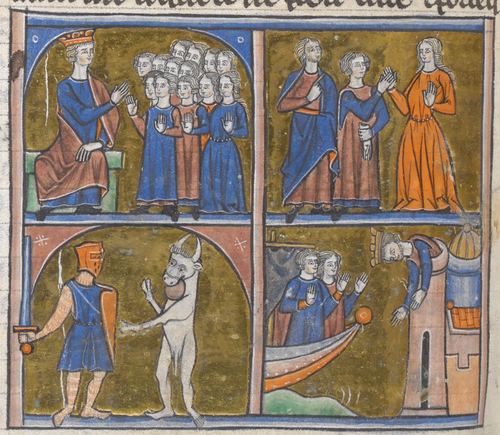Daedalus and the Minotaur in the Histoire ancienne jusqu’à César: from fact checking to post-truth
The version of the Histoire ancienne jusqu’à César in Paris, BnF, f. fr. 20125 is obsessively concerned with veracity. Our narrator continuously questions the reliability of other accounts, correcting them where necessary and simultaneously authenticating his more ‘truthful’ version.
In Maria Teresa’s blog on Daire le Roux, she discusses how Daire’s story is omitted because it is considered untrue. Indeed, it is deemed a tale told merely for entertainment, as is often the case: ‘Mais por beau parler est mainte choze contee et dite que n’est mie voire en tote [sic] traitié d’estorie.’ (BnF, fr. 20125, f. 114va) [But in order to speak pleasingly, many things which are not true are told and related in accounts of the past.]
In the Eneas section, rather than omitting a frivolous tale, the narrator includes two accounts of the same story, the second correcting the first. It concerns Daedalus and the Minotaur, who are introduced after Eneas’s arrival on the island of Euboea. This differs from the principal source for this section, Virgil’s Aeneid, in which Aeneas lands on Cumae. It is there that he visits the temple Daedalus built, which is adorned with the tale of the Minotaur and his escape from King Minos. In the Histoire ancienne, the arrival on Euboea segues into the story of Dedalus in quite different terms:
§608, 4-7
Aprés ce il ariverent et pristrent port en une isle, qui Eulioea estoit apelee, et si avoit une cité, Calchis estoit nomee. De cele cité issirent gent qui en Campaigne en funderent une des cités qu'il Cumas nomerent. Campaigne si est par dela Rome, et si fu ensi nommé et apelee dou non Capis le neveut Eneas, qui la tint et pupla quant Eneas et Ascanius orent Itale conquise. Cele cité Cumas vos ai ci rementeue por ce que li pluisor ont oi parler de Dedalus, et la s'en fui il por la paor dou roi Minos de Crete, qui le vout ocire. Li pluisor sevent bien l'ochoison por quoi il vout ce faire et assés i a qui ne le sevent mie, ains cuident de la fable que [158ra] ce soit verités et la verité ne conoissent mie. Mais totes ores, ains que je d'Eneas die avant, dirai je quels hom Dedalus fu et porquoi il guerpi sa contree.
[After this they arrived and landed on an island, which is called Euboea, and there was a city there named Chalcis. The people from this city founded the city named Cumae in Campania. Campania is beyond Rome, and was named after Eneas’s nephew, Capis, who ruled and colonised the land when Eneas and Ascanius had conquered Italy. I have reminded you of this city Cumae here because many have heard about Daedalus, and there he fled because of his fear of King Minos of Crete, who wanted to kill him. Many know well the reason why he wanted to do this and there are many who do not know. Rather, they believe that the fiction is the truth and yet they do not know the truth. But all the same, before I say more about Eneas, I will speak about the kind of man Daedalus was and why he left his country.]

Miniature of the labyrinth, Paris, BnF, f. fr. 20125, f. 158r (source: gallica.bnf.fr).
Eneas’s arrival on the Greek island of Euboea is geographically confusing given that he was just in Sicily. The loss of his helmsman, Palinurus, during the journey could be generously given as a narrative excuse for Eneas and his fleet completely missing Italy! But more importantly in this context, the introduction of Euboea offers an opportunity to trace back the origins of Cumae in a move typical of the Histoire ancienne in fr. 20125, which exploits every opportunity to add ‘historical’ and (pseudo-)etymological details. It is also noteworthy that Italy is being considered from a North to South perspective (Campania is located ‘par dela’ [beyond] Rome), suggesting a view of the peninsula from Northern Europe.
The narrator then explains to the reader why he has paused the narration at this point (‘vos ai ci rementeue’ [I have reminded you here]): to acknowledge Daedalus’s well-known association with Cumae, and specifically to correct the untruthful accounts of why he fled there. The chronological jump in the narration of Europe’s past is thus justified by the narrator’s tireless quest to eliminate 'fictional' falsitudes.

Miniature of Ariadne and Theseus next to the labyrinth, Paris, BnF, f. fr. 168, f. 144r (source: mandragore.bnf.fr).
The first account concerns the mythological version of Minos and Pasiphae, the Minotaur she gives birth to and the labyrinth designed by Daedalus to contain the Minotaur (see image above). At this time, the Athenians had to send seven young men and seven young women to be fed to the Minotaur. Theseus’s turn was next. Fortunately for him, Ariadne, King Minos’s daughter, falls in love with him, and with the help of Daedalus, comes up with a ruse to help Theseus escape the Minotaur’s clutches. After succeeding, Theseus leaves with Ariadne. King Minos discovers Daedalus’s role in his escape and imprisons him and his son Icarus. They escape from prison by fabricating wings and flying out of a window. But Icarus flies too close to the sun and the wax on his wings melts, causing him to fall and die. Daedalus then travels to Sardinia and on to Cumae.
At this point, the narrator interjects: ‘Ce en content li pluisor, qui en faillent, mais a briés mos vos en dirai la verité de l'estorie’ (§609.4, fr. 20125 f. 158vb) [So say the majority, who are wrong, but I will briefly tell you the truth of the story]. Following Servius’s commentary on Aeneid VI.14, the Histoire ancienne provides an alternative, ‘truthful’ account, in which the more fanciful elements, such as the monstrous Minotaur and Daedalus’s escape, are rationalised. Rather than conceiving a half-man, half-bull hybrid, in this account Pasiphae gives birth to two children at once: one by her husband Minos, and another by a notary called Taurus. Daedalus also plays a role, letting Pasiphae meet her lover at his house. Minos finds out and imprisons Daedalus and his son. Rather than flying out of the windows of the prison, Daedalus and Icarus are helped by Pasiphae and escape in a boat, but Icarus falls overboard and drowns. The narrator concludes: ‘Dedalus s'en ala et guoverna sa nef tant qu'il vint a Cumes. Tant en content par verités les estories’ (§609.5-6, fr. 20125 f. 159ra) [Daedalus escaped and steered his boat to Cumae. This is what the history books truly recount.]

Theseus slaying the Minotaur, British Library, Royal 20 D I, f. 201r. Reproduced with the permission of the British Library Board.
In an ironic twist, the second, more ‘truthful’, version of the legend is absent from a number of manuscripts, such as British Library, Add. 19669, BnF, f. fr. 17177, Chantilly, Bib. du Chat. 726, and our second redaction manuscript, British Library, Royal 20 D I. For the readers of these copies, 'fiction' becomes 'truth'. Only the mythological story remains and the less credible elements are left uncorrected. Even the introduction of the Daedalus episode (as cited above) does not mention the existence of conflicting accounts:
Aprés il pristrent port en une ille qui est apelee Euliolea [et] si avoit une cite Chathis avoit non dou non Capis le neveu Eneas qui la tint [et] puepla q[ua]nt Eneas ot conquis Ytale. Ceste cite v[os] ai ramenteu por ce que li plusor ont oi parler de Dedalus. [Et] la s’enfoi il por la paor dou roi Minos de Crete qu’il le voloit occirre. Je vos dirai l’achaison [et] lairai ·i· petit d’Eneas. (BL, Add. 19669, f. 97va)
[Afterwards they landed on an island, which is called Euboea, and there was a city named Chalcis after Capis, Eneas’s nephew, who ruled and settled there when Eneas had conquered Italy. I reminded you of this city because many have heard about Daedalus. And he fled there because of his fear of King Minos of Crete, who wanted to kill him. I will tell you the reason and will leave Eneas for a moment.]

Scenes depicting the adventures of Theseus, British Library, Additional 19669, f. 96vb. Reproduced with the permission of the British Library Board.
These lines discard and distort many of the ‘facts’ mentioned in the equivalent passage in fr. 20125. Capis is said to have settled in the Greek city Chalcis rather than Campania, and the foundation of Cumae is omitted. This abbreviated version thus befuddles the very reason for the interlude about Daedalus. (Yet, the account in Add. 19669 still concludes with Daedalus escaping to Cumae, and not Chalcis.)
After shedding the details so fundamental to fr. 20125, we are left with what could be described as the post-truth version. By favouring (and highlighting the appeal of) the mythological account, its brevity and distortion silently deride the attempts at verification so characteristic of the Histoire ancienne in fr. 20125.
Further Reading
Maurus Servius Honoratus, Servii Grammatici qui feruntur in Vergilii carmina commentarii, ed. by Georgius Thilo and Hermannus Hagen (Leipzig: B. G. Teubner, 1881), vol. II, part 2.
Jacques Monfrin, 'Les translations vernaculaires de Virgile au Moyen Âge', in Lectures médiévales de Virgile: Actes du Colloque organisé par l'Ecole française de Rome (Rome, 25-28 octobre 1982) (Ecole française de Rome, 1985), pp. 189-249.